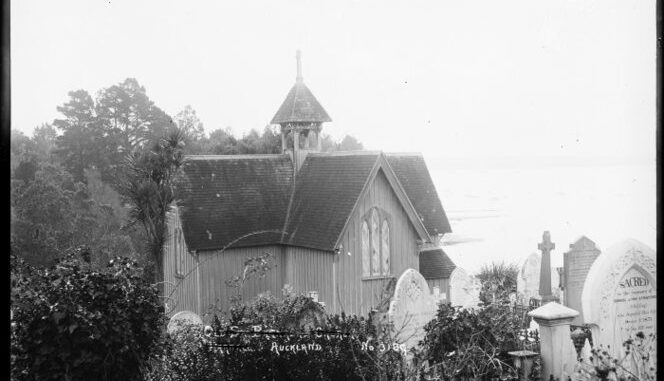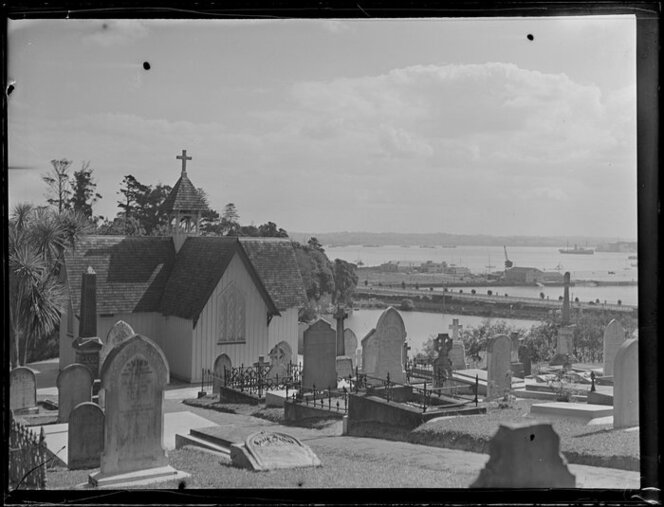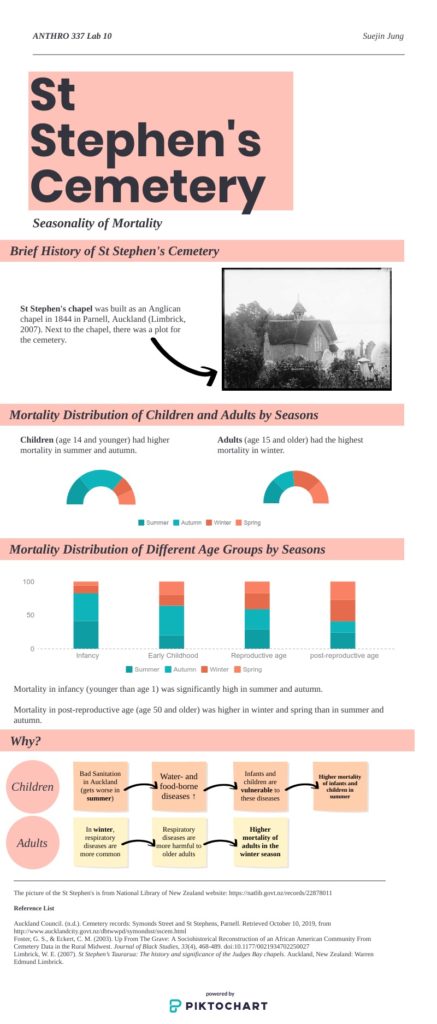
by: Heather Battles, University of Auckland
In my article for Teaching Anthropology (Battles, 2020), I used a case study of my experience with a cemetery project in an anthropological demography course in 2016, as an example of a hybrid approach aimed getting the benefits of project-based and service learning in courses that don’t meet the ideal pre-conditions for that kind of strategy (which are small class sizes, with high levels of instructor support but significant student autonomy).
This course at the University of Auckland in Aotearoa/New Zealand was officially titled “Birth, Death, and Disease: Anthropological Demography” and was taught for the first time in 2016 and next in 2019. Enrolment was 40 undergraduates in 2016, and 45 in 2019, mostly in their third/final year of their Bachelor’s programmes (both BA and BSc). A key aspect of the course was students learning how to collect, analyse, and present demographic data. Students worked with demographic data from a local cemetery, derived from headstone inscriptions and burial records. The focus for the 2019 project was St Stephen’s Anglican churchyard cemetery, located in inner Auckland suburb of Parnell. St Stephen’s began operation in the 1840s, with burials peaking in the 1880s but continuing into the late 20th century.

For the 2019 class, I changed the assessment structure to some degree. For St Stephen’s, students were working directly from a transcribed database (rather than collecting the headstone inscription data themselves), so there was no two-part process of comparison between datasets. This helped to address one of the challenges from 2016 which was the high complexity of the project. It also meant that we (unintentionally) avoided the issue of cultural or physical accessibility barriers to in-person data collection. In 2019, the first assignment was an annotated bibliography of sources to use to interpret their labwork results. The report was their second, final assignment. The general assessment structure was otherwise the same as in 2016, apart from some changes to the computer labs, such as addition an exercise in which students made infographics (see Figure 1 for an example).
In 2019, I conducted a post-experience survey that specifically asked about the Project, rather than relying on the standard university course evaluations. The survey was conducted after final exam, before final marks posted. The survey invitation received 17 responses (37.8% of 45 students enrolled, or 43.6% of the 39 who submitted Assignment 2).
In response to the statement, “Working with ‘real’ data increased my motivation and the effort I put into my project coursework”, all respondents “agreed” (52.9% ‘strongly agree’, 47.1% ‘agree’). The response to the statement, “Working on a local history topic increased my motivation and the effort I put into my project coursework” was slightly different (only 70.6% agreed). However, those students who particularly enjoyed the project might also have been more likely to have filled out the survey, so I’m cautious that I’m not getting the entire spectrum of experiences. Tables 1 and 2 contain some representative student comments from the survey.
Table 1:
| What was the most useful or valuable aspect of the cemetery project for you? What was the most valuable thing(s) you learned? |
| I really, really enjoyed learning more about Auckland. I’ve never really paid much attention to New Zealand history so this assignment was a great opportunity to familiarise myself with historical Auckland and it’s made me feel more intimate with this city (which is weird because I’ve lived here all my life). It taught me to appreciate this little slice of paradise and I also learnt a lot about the historical development of Auckland and New Zealand. |
| Applying demographic theory learned in lecture/readings to the statistical findings from the cemetery data and local history around St Stephens was a really enjoyable challenge. I found it valuable as it forced you to think critically about the data from both a method/data collection perspective and a theoretical one, particularly when results didn’t fully match predictions and one had to really think about what other factors were involved. This is the only course that I know of that has this form of practical assessment and I really wish more did! |
Table 2:
| Can you suggest ways in which the cemetery project activity or experience could be improved? |
| Having a physical visit to the site with the class would be more enriching and fascinating, and it would draw more students to be invested in the data and the local history research, which was the least fascinating aspect of the project for me. |
| If time allowed, I think it would be useful if the students in the course were the ones to carry out the transcribing of the headstone data. |
I was happy to see that many of the students’ survey answers (see Table 1) spoke to what project-based learning is meant to achieve. In terms of improvements, among various comments about more help with statistical testing or more latitude with the report structure or methods, several students commented that they would like to have done some of the ‘fieldwork’ at the cemetery themselves, like the 2016 class did (see Table 2). Some students also said they had taken it upon themselves to visit St Stephen’s cemetery on their own time.
A number of things were different in the 2019 iteration of the course, but the key elements of working with real data and structural scaffolding of coursework remained, and continued to be beneficial. It came as a bit of a surprise to me that local history was not of inherent or automatic interest to the students, and that is something to take into consideration in course design (e.g., the student comments point to the value of in-person interaction with the site). However, all elements of the course could be accomplished in an online environment. In the current pandemic context in which in-person teaching and learning might not be an option or be otherwise restricted, a hybrid approach could be a useful strategy for achieving at least some of the benefits of project- and service-based learning.
References:
Heather T. Battles (2020) Teaching anthropological demography through project- and service-based learning: Case study of the Symonds Street Cemetery Project. Teaching Anthropology 9(1): 59–73. DOI: https://doi.org/10.22582/ta.v9i1.471
Figure 1. Infographic on seasonality of mortality in St Stephen’s Cemetery by student Suejin Jung.


Leave a Reply
You must be logged in to post a comment.